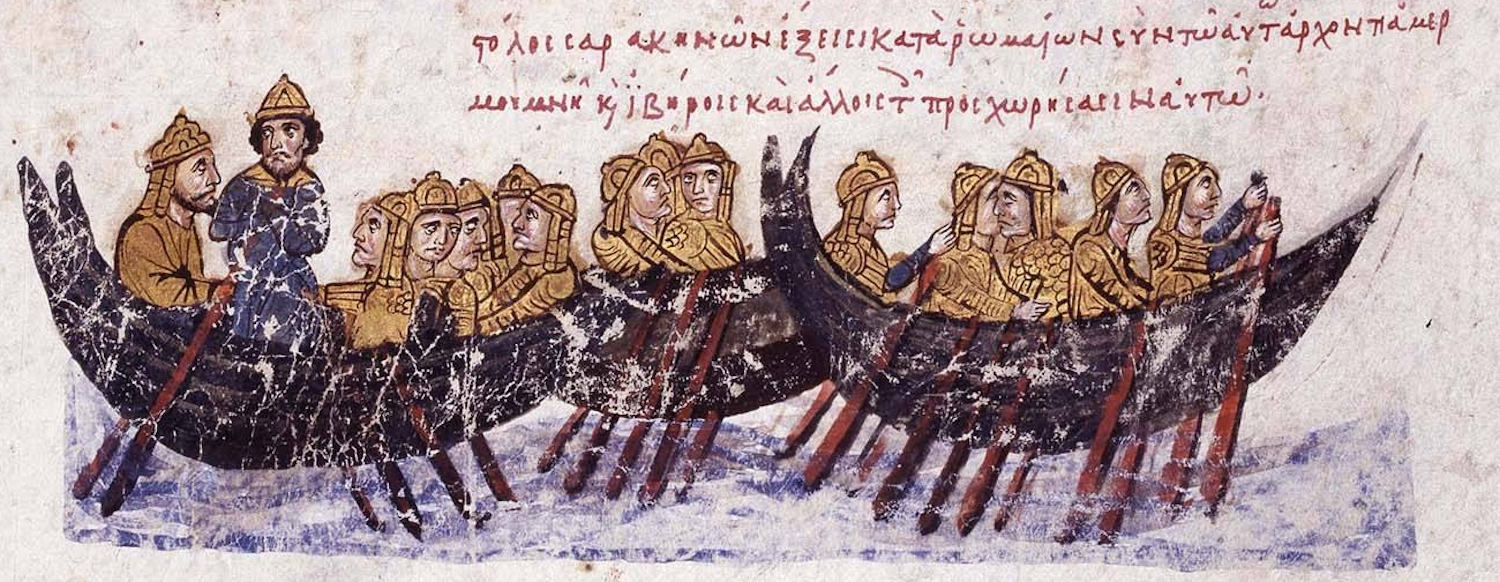824-961
The Emirate of Crete
In 824 (or possibly in 827/828 according to other sources) Crete was conquered by a group of Muslims (Moors) from Andalusia, which then established an independent state on the island. An emirate, which came to exist for the next approx. 135-40 years. The Byzantine Empire made repeated attempts to recapture the island, but didn't succeed until 961 under general Nikiphoros Phokas. Subsequently Crete was again part of the Byzantine Empire until the island was lost to the Venetians in 1204.
I 818 there was a revolt against the rule of emir Al-Hakam I of Córdoba in Andalusia, Spain. The revolt failed and afterwards thousand of citizens were expelled from Córdoba. Some went to other countries like Morocco where they settled. But perhaps as many as 10.000 took to piracy. And at some point some of these exiles landed on Crete. Muslim sources date this to have happened in 827 or 828. Byzantine sources say 824, which seem to be more accurate according to modern historians.
The exiles had initially taken control of Alexandria in Egypt, but there they were besieged and expelled. They left with their families in 40 ships numbering probably around 12.000 people. Nobody knows where on Crete they first arrived, but soon after they founded a city and a fortress which they called Chandax, (meaning 'Castle of the Moat'), transferring the capital of Crete from Gortyn.
When the Byzantine emperor Michael II heard of the Andalusians on Crete he sent out expeditions to reconquer the island. The first expedition failed and so did the second a year after. The third expedition took place in 843. This time the Byzantine 'logothetes' Theoktistos managed to conquer part of Crete. But intrigues at the court in Constantinople forced him to return home and the troops he left behind were soon after slaughtered by the Muslims.
A fourth attempt was made in 866, when the Byzantine Caesar Bardas assembled a large force. But Caesar Bardas was murdered two weeks after the fleet had left for Crete an so the expedition was cancelled. Then in 911, the admiral Himerios launched another large-scale expedition of more than 100 ships against Crete. But again the Byzantines lost. Their fleet was destroyed by a combined Cretan and Syrian fleet. Finally, Emperor Constantine VII sent another expedition in 949, which turned out to be just as unsuccessful as all the others.
In between all these attempt from the successive Byzantine emperors to reconquer their lost possession, the Muslims on Crete consolidated their control of the island. The new rulers of Crete recognized the suzerainty of the Abbasid Caliphate, but ruled independently over their emirate on Crete.
The conquest of Crete changed the balance of power in the Eastern Mediterranean. The Aegean islands and littoral states were exposed to frequent raids and the Muslims on Crete became one of the major foes of the Byzantine empire. Sometimes joined by North African and Syrian fleets they attacked southern Greece, the western coasts of Asia Minor and several of the islands.
Life on Crete in the period
Life on Crete during the emirate is not very well known. Firstly, it was only a short period in history. Secondly, when the Byzantine empire finally succeeded in reconquering the island they did much to eradicate all traces of the Muslim presence on Crete. They thoroughly destroyed the city of Chandax, tore down its mosques and walls, killed the inhabitants or carried them off into slavery.
If one relies mainly on Byzantine accounts, the Emirate of Crete would have been an unruly place full of pirates. Sources from the Muslim world, however, talk about an ordered state with extensive trade with the rest of the Muslim world, high living standards and a strong economy. And the capital Chandax was an important cultural centre.
Whether any Christians were left on the island after the Muslim conquest is unclear. Perhaps they were expelled or they converted to Islam. Perhaps there were isolated areas on the island where they still lived.
The reconquest of Crete
When it finally managed to recapture Crete, Byzantium had to use all its military superiority. At the end of 960 the Byzantine general and later emperor, Nikiphoros Phocas arrived with a fleet of 3.000 vessels and a 6 month long attack began. Finally, in March 961 he managed to take the Muslims capital Kandax or Handakas (modern Heraklion). The rest of Crete fell rapidly thereafter.
The Muslims of Crete were killed, enslaved or expelled and Kandax was robbed. It is said that 300 ships were needed to bring home the wealth. As the population had dropped during the emirate colonies of Greeks, Armenians and Slavs were created shortly after the reconquest of Crete to repopulate the island. There was also quickly sent Christian missionaries to the island and great efforts were made to ensure people's attachment to the Christian faith after the time under Muslim domination.
Sights from the period in modern Crete
No major archaeological remains from the period survive in Crete. Except for remains of the fortification in Heraklion and a few coins nothing much has been found.
The Arab name of the capital city Chandax or al-Khandaq survived and came to mean all of Crete in the Middle Ages (Candia).
Some place names, such as Sarkenos, Souda, Aposelemis (Abu Salim) and Choumeri also bear witness of the emirate on Crete.

